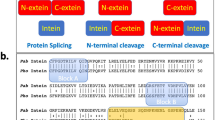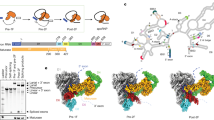Abstract
The backbone resonance assignments of an engineered splicing-inactive mini-RecA intein based on triple resonance experiments with [13C,15N]-labeled protein are reported. The construct contains inactivating mutations specifically designed to retain most catalytic residues, especially those that are potentially metal-coordinating. The assignments are essential for protein structure determination of a precursor with an active N-terminal catalytic cysteine and for investigation of the atomic details of splicing.

Similar content being viewed by others
References
Amitai G, Callahan BP, Stanger MJ, Belfort G, Belfort M (2009) Modulation of intein activity by its neighboring extein substrates. Proc Natl Acad Sci U S A 106(27):11005–11010
Belfort M (1998) Inteins as antimicrobial targets: genetic screens for intein function, Google Patents
Callahan BP, Topilina NI, Stanger MJ, Van Roey P, Belfort M (2011) Structure of catalytically competent intein caught in a redox trap with functional and evolutionary implications. Nat Struct Mol Biol 18(5):630–633
Dearden AK, Callahan B, Roey PV, Li Z, Kumar U, Belfort M, Nayak SK (2013) A conserved threonine spring-loads precursor for intein splicing. Protein Sci 22(5):557–563
Du Z, Liu Y, Zheng Y, McCallum S, Dansereau J, Derbyshire V, Belfort M, Belfort G, Van Roey P, Wang C (2008) 1H, 13C, and 15 N NMR assignments of an engineered intein based on Mycobacterium tuberculosis RecA. Biomol NMR Assign 2(2):111–113
Du Z, Liu J, Albracht CD, Hsu A, Chen W, Marieni MD, Colelli KM, Williams JE, Reitter JN, Mills KV, Wang C (2011a) Structural and mutational studies of a hyperthermophilic intein from DNA polymerase II of Pyrococcus abyssi. J Biol Chem 286(44):38638–38648
Du Z, Zheng Y, Patterson M, Liu Y, Wang C (2011b) pK(a) coupling at the intein active site: implications for the coordination mechanism of protein splicing with a conserved aspartate. J Am Chem Soc 133(26):10275–10282
Hiraga K, Derbyshire V, Dansereau JT, Van Roey P, Belfort M (2005) Minimization and stabilization of the Mycobacterium tuberculosis recA intein. J Mol Biol 354(4):916–926
Hiraga K, Soga I, Dansereau JT, Pereira B, Derbyshire V, Du Z, Wang C, Van Roey P, Belfort G, Belfort M (2009) Selection and structure of hyperactive inteins: peripheral changes relayed to the catalytic center. J Mol Biol 393(5):1106–1117
Johnson MA, Southworth MW, Herrmann T, Brace L, Perler FB, Wuthrich K (2007) NMR structure of a KlbA intein precursor from Methanococcus jannaschii. Protein Sci 16(7):1316–1328
Keller RLJ (2004) The computer aided resonance assignment tutorial. Switzerland, Cantina Verlag
Klabunde T, Sharma S, Telenti A, Jacobs WR Jr, Sacchettini JC (1998) Crystal structure of GyrA intein from Mycobacterium xenopi reveals structural basis of protein splicing. Nat Struct Biol 5(1):31–36
Lew BM, Paulus H (2002) An in vivo screening system against protein splicing useful for the isolation of non-splicing mutants or inhibitors of the RecA intein of Mycobacterium tuberculosis. Gene 282(1–2):169–177
Liu Z, Frutos S, Bick MJ, Vila-Perello M, Debelouchina GT, Darst SA, Muir TW (2014) Structure of the branched intermediate in protein splicing. Proc Natl Acad Sci U S A 111(23):8422–8427
Moure CM, Gimble FS, Quiocho FA (2002) Crystal structure of the intein homing endonuclease PI-SceI bound to its recognition sequence. Nat Struct Biol 9(10):764–770
Muir TW (2003) Semisynthesis of proteins by expressed protein ligation. Annu Rev Biochem 72:249–289
Oeemig JS, Zhou D, Kajander T, Wlodawer A, Iwai H (2012) NMR and crystal structures of the Pyrococcus horikoshii RadA intein guide a strategy for engineering a highly efficient and promiscuous intein. J Mol Biol 421(1):85–99
Paulus H (2000) Protein splicing and related forms of protein autoprocessing. Annu Rev Biochem 69:447–496
Peck SH, Chen I, Liu DR (2011) Directed evolution of a small-molecule-triggered intein with improved splicing properties in mammalian cells. Chem Biol 18(5):619–630
Pereira B, Shemella PT, Amitai G, Belfort G, Nayak SK, Belfort M (2011) Spontaneous proton transfer to a conserved intein residue determines on-pathway protein splicing. J Mol Biol 406(3):430–442
Romanelli A, Shekhtman A, Cowburn D, Muir TW (2004) Semisynthesis of a segmental isotopically labeled protein splicing precursor: NMR evidence for an unusual peptide bond at the N-extein-intein junction. Proc Natl Acad Sci U S A 101(17):6397–6402
Sun P, Ye S, Ferrandon S, Evans TC, Xu MQ, Rao Z (2005) Crystal structures of an intein from the split dnaE gene of Synechocystis sp. PCC6803 reveal the catalytic model without the penultimate histidine and the mechanism of zinc ion inhibition of protein splicing. J Mol Biol 353(5):1093–1105
Topilina NI, Mills KV (2014) Recent advances in in vivo applications of intein-mediated protein splicing. Mob DNA 5(1):5
Van Roey P, Pereira B, Li Z, Hiraga K, Belfort M, Derbyshire V (2007) Crystallographic and mutational studies of Mycobacterium tuberculosis recA mini-inteins suggest a pivotal role for a highly conserved aspartate residue. J Mol Biol 367(1):162–173
Wood DW, Wu W, Belfort G, Derbyshire V, Belfort M (1999) A genetic system yields self-cleaving inteins for bioseparations. Nat Biotechnol 17(9):889–892
Wood DW, Derbyshire V, Wu W, Chartrain M, Belfort M, Belfort G (2000) Optimized single-step affinity purification with a self-cleaving intein applied to human acidic fibroblast growth factor. Biotechnol Prog 16(6):1055–1063
Wu WY, Mee C, Califano F, Banki R, Wood DW (2006) Recombinant protein purification by self-cleaving aggregation tag. Nat Protoc 1(5):2257–2262
Zhang L, Zheng Y, Callahan B, Belfort M, Liu Y (2011) Cisplatin inhibits protein splicing, suggesting inteins as therapeutic targets in mycobacteria. J Biol Chem 286(2):1277–1282
Acknowledgments
This work was supported by NIH Biomolecular Science and Engineering training grant GM067545 (C.S.P.), NIH Grant GM44844 (M.B.), and NIH grant GM085006 (A.S.).
Author information
Authors and Affiliations
Corresponding author
Rights and permissions
About this article
Cite this article
Pearson, C.S., Belfort, G., Belfort, M. et al. Backbone assignments of mini-RecA intein with short native exteins and an active N-terminal catalytic cysteine. Biomol NMR Assign 9, 235–238 (2015). https://doi.org/10.1007/s12104-014-9581-z
Received:
Accepted:
Published:
Issue Date:
DOI: https://doi.org/10.1007/s12104-014-9581-z




